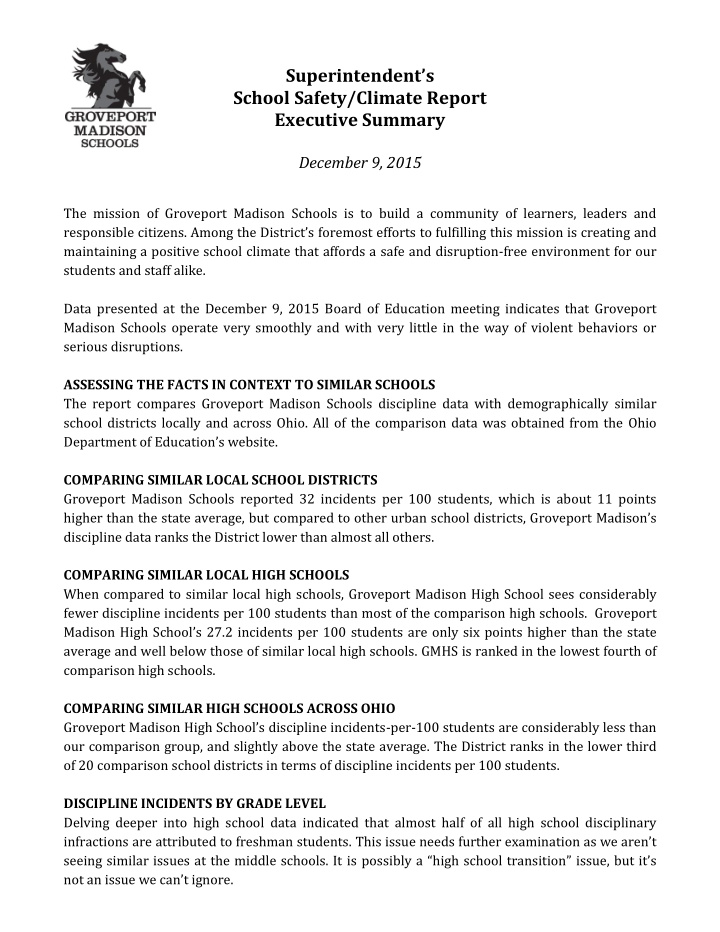



Superintendent’s School Safety/Climate Report Executive Summary December 9, 2015 The mission of Groveport Madison Schools is to build a community of learners, leaders and responsible citizens. Among the District’s foremost efforts to fulfilling this mission is creating and maintaining a positive school climate that affords a safe and disruption-free environment for our students and staff alike. Data presented at the December 9, 2015 Board of Education meeting indicates that Groveport Madison Schools operate very smoothly and with very little in the way of violent behaviors or serious disruptions. ASSESSING THE FACTS IN CONTEXT TO SIMILAR SCHOOLS The report compares Groveport Madison Schools discipline data with demographically similar school districts locally and across Ohio. All of the comparison data was obtained from the Ohio Department of Education ’s website. COMPARING SIMILAR LOCAL SCHOOL DISTRICTS Groveport Madison Schools reported 32 incidents per 100 students, which is about 11 points higher than the state average, but compared to other urban school districts, Groveport Madison’s discipline data ranks the District lower than almost all others. COMPARING SIMILAR LOCAL HIGH SCHOOLS When compared to similar local high schools, Groveport Madison High School sees considerably fewer discipline incidents per 100 students than most of the comparison high schools. Groveport Madison High School’s 27.2 incidents per 100 students are only six points higher than the state average and well below those of similar local high schools. GMHS is ranked in the lowest fourth of comparison high schools. COMPARING SIMILAR HIGH SCHOOLS ACROSS OHIO Groveport Madison High School’s discipline incidents -per-100 students are considerably less than our comparison group, and slightly above the state average. The District ranks in the lower third of 20 comparison school districts in terms of discipline incidents per 100 students. DISCIPLINE INCIDENTS BY GRADE LEVEL Delving deeper into high school data indicated that almost half of all high school disciplinary infractions are attributed to freshman students. This issue needs further examination as we aren’t seeing similar issues at the middle schools. It is possibly a “high school transition” issue, but it’s not an issue we can’ t ignore.
DISCIPLINE INCIDENTS BY INFRACTION The report also looked at high school discipline incidents by the type of infraction. While very few of the incidents are violent or destructive in nature, it’s evident that there are issues that we need to address. Attendance and tardies represent almost half of all discipline reports. It’s important to note that the data represents th e number of students, not the number of incidents. Therefore, a fight that involves five students would make up one-tenth of all reported fights for the 2013-2014 school year. WHAT DO OUR SCHOOL LEADERS HAVE TO SAY? The vast majority of the disciplinary infractions are non-violent, but frequently cause disruptions to teaching and learning and can create “tension” within the school. Principals report that they are seeing increasing numbers of students who are dealing with social and safety challenges in their neighborhoods which are becoming flashpoints at school. In spite of providing guidance and social service support in schools, students often lack the requisite skills and external support systems to help them appropriately deal with conflicts. Schools also report more incidents in which parents and/or adults have become involved in aggressive behaviors or physical altercations at schools. These incidents can be with another adult or even a student. WHAT DOES THE REPORT INDICATE? The data addresses some misconceptions of Groveport Madison Schools as it relates to discipline issues. While the District has issues that need to be addressed, it is clear that there is not a pervasive environment where students are involved in violent actions or fights at any of the District’s 10 schools. The District needs to have consistent data collection and reporting systems and to look more closely at discipline issues across all grade levels and determine if/how outside agencies can provide additional community support. Need to acknowledge that we can and must do more to help students develop conflict resolution skills. The District needs to leverage outside professional and community resources to help address neighborhood challenges that are faced by our students.
RECOMMENDATIONS 1. The Superintendent recommends the District convene community coalition to develop a strategic action plan to support students equip them with the tools and skills they need to effectively deal with conflicts. The coalition should represent a broad constituency of the community, including community leaders, social service organizations, faith leaders, school personnel, students, and parents, and other interested parties. Among the charges of the coalition is to identify how we can utilize community resources to better support families and neighborhoods within GM Schools. 2. The District needs to assess the current discipline data collection and reporting tools for all schools and set up a monitoring and reporting systems. 3. Leverage outside professional and community resources to help address neighborhood challenges that are faced by our students.
Recommend
More recommend